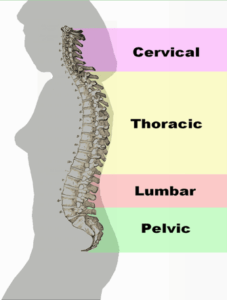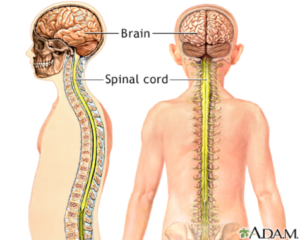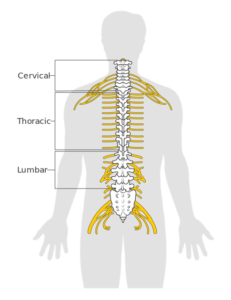“The doctor said I have a pinched spinal nerve.”
It’s a very common statement. But, while many patients know they have a pinched nerve, they may not know exactly what it is or how to treat it. To help guide you, we’ve created this post to educate and inform patients who have (or think they may have) a pinched spinal nerve.
Let’s jump right in:
Anatomy: The Spinal Column, Canal, and Cord
The spine has four regions: cervical, thoracic, lumbar, and pelvic.

Illustration 1– The four regions of the spine
The bones (vertebrae) of each region stack on top of one another to form the spinal canal, which creates a tunnel for the spinal cord to run from the brain to the lower back.

Each vertebra has a small hole that allows the spinal cord to branch out and innervate different muscles and organs.

Illustration 2– Nerves branch from the spinal cord
When a vertebra or spinal disc is damaged or diseased, it can pinch one of the nerves and cause a host of unpleasant symptoms such as localized or radiating pain, numbness or tingling in the extremities and loss of motor functions.
Causes of a Pinched Nerve
Degenerative disc disease, bone spurs, spinal stenosis and herniated discs are among the most common conditions that alter the anatomy of the spine and can cause a pinched spinal nerve. The most common causes of the above mentioned are:
- Age
- Motor vehicle accidents
- Sports accidents
- Whiplash injuries
- Heavy lifting injuries
- Arthritis
Once a nerve is pinched, symptoms develop and need to be treated.
Symptoms of a Pinched Nerve
Symptoms occur in the back and/or the area of the body that the pinched nerve innervates. Some of the most common symptoms are:
- Pain
- Weakness
- Numbness
- Tingling
All of these symptoms can cause day-to-day problems that will persist when left untreated.
Treatments for a Pinched Nerve
Any, all, or any combination of the following non-surgical treatment options can be used to decrease or eliminate symptoms:
- Anti-inflammatory medications
- Nonsteroidal anti-inflammatory drugs (NSAIDS)
- Physical therapy
- Activity modification
- Steroid injections
- Pain medications
If non-surgical treatment fails, the nerve may need to be decompressed via surgery.
Advances in Minimally Invasive Surgical techniques now allow spinal surgeons to access and decompress the spinal nerves using incisions as small as an inch and can be performed on an outpatient bases. The specific procedure used to decompress the spinal nerve(s) is based on your unique condition as well as your lifestyle, activities and goals.
The Role of a Neurosurgeon
The first step in treating a pinched nerve is obtaining a detailed history and a physical examination. After the underlying cause of the pinched nerve is determined, a treatment plan is prescribed and symptom relief occurs.
If you’ve been diagnosed with (or think you have a pinched nerve), please feel free to contact our office.
Dr. Patrick Senatus is a Board Certified Neurosurgeon in New York City with extensive experience in Minimally Invasive and Restorative Spine Surgery. Dr. Senatus employs a personalized patient-centered approach that prioritizes optimum functional outcome and well-being. Each consultation begins with a comprehensive evaluation by Dr. Senatus designed to create an individualized evidence based treatment plan which includes the patient, family, and collaborating providers.
Following a conservative treatment philosophy, Dr. Senatus offers his patients solutions using the most advanced minimally invasive procedures. His approach is to perform the most effective and least invasive intervention available, specifically tailored to each patient, guided by the principal that surgical options be considered only after all reasonable non-operative therapies have been exhausted. Returning his patients to a functional pain free lifestyle is the ultimate objective. Contact us today to schedule an appointment!


Recent Comments